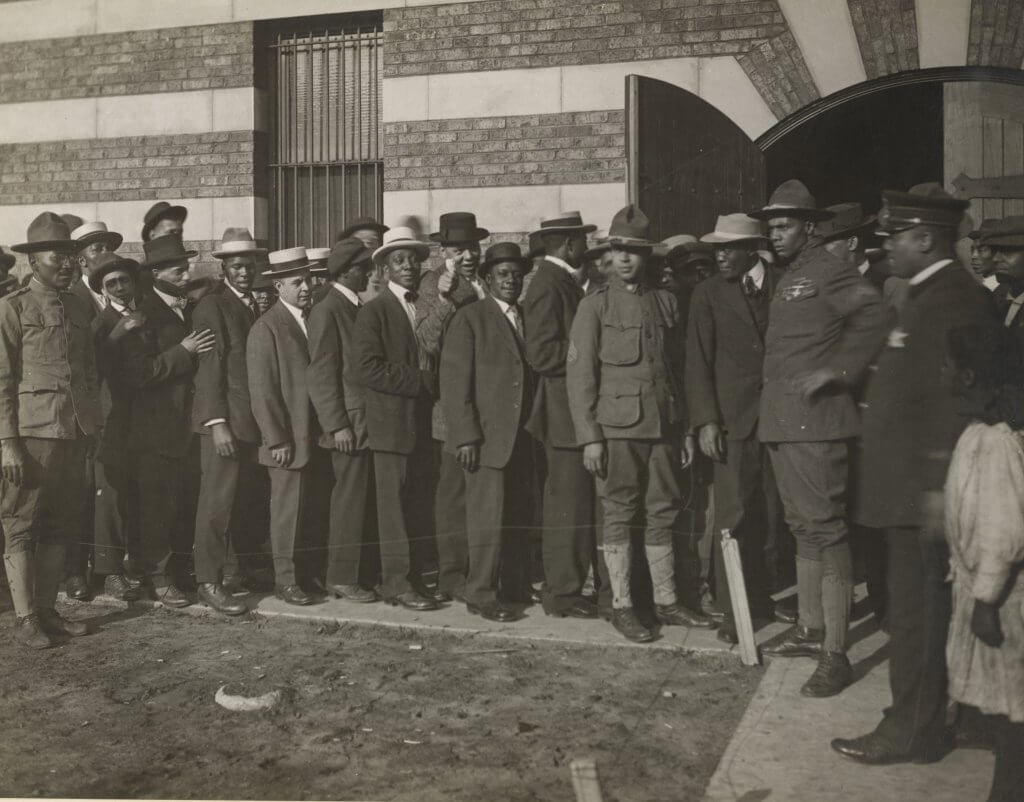The Houston Race Riot of 1917 resulted in what’s known as the largest court-martial in U.S. military history. That August, 20 people were left dead after soldiers from the 24th Infantry Division clashed with white police officers on the streets near Camp Logan, Texas.
“The white citizens were apprehensive about the presence in their city of armed Blacks [soldiers] wearing the uniform of the United States Army, especially since as military guards the soldiers would be in a position to exercise authority over them,” Robert Haynes said in his 1973 report for “The Southwestern Historical Quarterly.”
At the same time, the 8th Illinois Regiment – the first all-Black National Guard unit and the first to be commanded by Black officers – became federalized and headed to Houston for training. The troops arrived at Camp Logan in October 1917, two months before 13 soldiers from the 24th Infantry Division were executed for their role in the riot.
RELATED: Washington Guard helped defend US after Pearl Harbor attack
Soldiers from the 8th were recruited from prominent Black neighborhoods in Chicago and Springfield. Areas like Bronzeville, Illinois, were like a “city-within-a-city” where Black residents had established their own political base, economy and press, much like Tulsa, Oklahoma, which was known as “Black Wall Street” at the time.
Fighting 8th viewed as a source of pride
Robert Jefferson Jr., a professor of Black history at the University of New Mexico, said the neighborhoods also had their own soldiers, the “Fighting 8th,” who residents upheld as a focal point in the community and a source of race pride.
“It was not uncommon to walk into someone’s home and see a photograph of a soldier from the 8th Illinois hanging on the wall,” he said. “They were our Barack Obamas or the people we know as the most notable African-Americans in our society today. They were our long-distance runners and the ones we pointed to as being the yardstick for achieving full equality in American society.”
Heroes in their communities but Black nonetheless; the troops were required to overcome and endure training through heightened racial tensions in Houston and then in Newport News, Virginia’s segregated, Jim Crow south.
Upon their deployment to Europe during World War I, the 8th was redesignated as the 370th Infantry Regiment, 93rd Infantry Division, and was determined to serve in combat. Members of the 370th rejected the notion Black soldiers wouldn’t stand to fight and should only perform garrison and logistical duties.
“For many of those who served in units like the 8th Illinois, this was their chance to prove not only who they were as African-Americans, but who they were as men,” Jefferson said.
‘Black manhood’
“Black manhood” is a common theme in the discussion on why Black troops would enthusiastically volunteer to fight for a country that denied them fundamental rights and equality at home. In his report, Haynes cited soldiers’ hopes of being afforded the same privileges and respect other men in uniform if they proved they were worthy in combat.
Army Gen. John J. Pershing commanded the American Expeditionary Forces in Europe and, according to Jefferson, resented the thought of Black soldiers facing combat with the French but made an exception to fulfill manpower shortages.
When they arrived, the 370th was refitted with French uniforms and equipment to ultimately prove they could not only function under direct fire but operate as an organized unit.
“They got a sense of this transnational feeling of fellowship… and saw what true, interracial democracy might look like,” Jefferson said. “They saw rank discrimination exhibited by the American forces while also seeing this enlightened sense of a new world coming into being.”
‘Black Devils’ earn plethora of honors
As they addressed French civilians’ questions about rumors to say “Black soldiers had tails,” the men of the 370th conducted themselves in a manner to leave a legacy of valor.
They became known to their German adversaries as the “Black Devils” for their fighting capabilities and received 21 Distinguished Service Crosses, one Distinguished Service Medal and 68 Croix de Guerre. Lt. Col. Otis B. Duncan was the highest-ranking Black officer to serve in combat during World War I and was awarded a Croix de Guerre.
Later units would be sure to emulate and attempt to live up to the 370th’s discipline and battle superiority. But Jefferson also said the 8th Illinois’ legacy is one of camaraderie and unit cohesion.
“They were very much responsible to each other,” he said. “This unit in particular, would not be discouraged by the racial [prejudices] taking place around them. If anything, it had the tendency to make them come together as a collective.”
Members of the 370th received a hero’s welcome when they returned to Chicago. Citizens collected donations to erect the Victory Monument in 1925, which stands in Bronzeville today as a dedication to the Fighting 8th and a symbol of the community’s identity. The 178th Infantry, Illinois National Guard carries the legacy of the 370th and deployed in 2008 to support Operation Enduring Freedom.
Jefferson added, systemic racism to this day has denied some distinguished members of the 8th Illinois recognition for their sacrifice and selfless service. Other notable Black military units that have blazed a path forward but may not have been fully recognized include:

